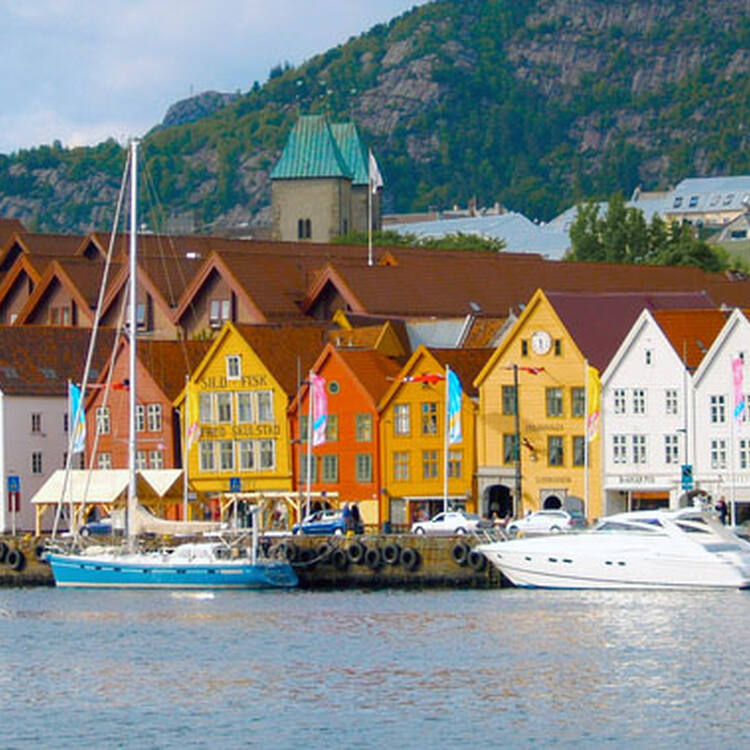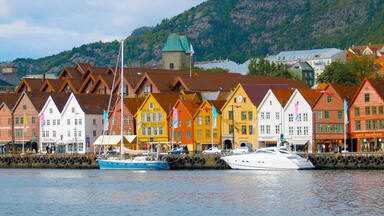Bryggen
Bryggen
Bryggen, the old wharf of Bergen, is a reminder of the town’s importance as part of the Hanseatic League’s trading empire from the 14th to the mid-16th century. Many fires, the last in 1955, have ravaged the characteristic wooden houses of Bryggen. Its rebuilding has traditionally followed old patterns and methods, thus leaving its main structure preserved, which is a relic of an ancient wooden urban structure once common in Northern Europe. Today, some 62 buildings remain of this former townscape.
Description is available under license CC-BY-SA IGO 3.0
Quartier de « Bryggen » dans la ville de Bergen
Bryggen, le vieux quai de Bergen rappelle l’importance de la ville comme élément de l’empire commercial de la Ligue hanséatique, du XIVe siècle au milieu du XVIe siècle. De nombreux incendies, dont le dernier en 1955, ont ravagé les maisons typiques en bois de Bryggen. Sa reconstruction a traditionnellement repris les anciennes méthodes et modèles, (ainsi en laissant)sa structure principale a été préservée, qui est une relique d’une ancienne structure urbaine en bois autrefois commune dans le nord de l’Europe. Aujourd’hui, environ 62 immeubles persistent dans cet ancien townscape.
Description is available under license CC-BY-SA IGO 3.0
حيّ بريغين في مدينة بيرغن
يذكرنا حيّ بريغين وهو رصيف بيرغن القديم، بأهمية هذه المدينة كعنصر من امبراطورية الجامعة التحالفية التجارية التي امتدت من القرن الرابع عشر وحتى منتصف القرن السادس عشر. وقد دمرت حرائق عدة آخرها في العام 1955، المنازل النموذجية المصنوعة من خشب بريغين. وتطلّبت اعادة بنائها اعتماد الوسائل والنماذج القديمة وفقًا للتقليد والمحافظة على بنيتها الاساسية التي تشكل ذخيرة البنية المدنية الخشبية القديمة التي كانت في وقت من الاوقات شائعةً في شمال أوروبا. وما زال حوالي 62 مبنى صامدًا حتى اليوم في هذه المدينة الجميلة القديمة.
source: UNESCO/CPE
Description is available under license CC-BY-SA IGO 3.0
卑尔根市布吕根区
布吕根地区是卑尔根的一个旧码头,该遗迹告诉人们这是14世纪到16世纪中叶汉萨同盟贸易帝国的一个重镇。多起火灾(最后一起是在1955年) 烧毁了布吕根地区美丽的木头房子,但是其主要建筑仍然保存下来。如今残存的58幢建筑大部分被用作艺术家的工作室。
source: UNESCO/CPE
Description is available under license CC-BY-SA IGO 3.0
Старый портовый квартал Брюгген (город Берген)
Брюгген, старая верфь Бергена, напоминает о важности этого города в торговой империи Ганзейского союза в период с XIV в. до середины XVI в. Многочисленные пожары (последний в 1955 г.) разрушили красивые деревянные постройки Брюггена, но его основная структура сохранилась. Многие из уцелевших 58 зданий теперь используются как студии художников.
source: UNESCO/CPE
Description is available under license CC-BY-SA IGO 3.0
Barrio de Bryggen en Bergen
El barrio antiguo del muelle de Bryggen recuerda la importancia que tuvo la ciudad de Bergen en el imperio comercial de la Liga Hanseática, desde el siglo XIV hasta mediados del siglo XVI. Las típicas casas de madera de este barrio fueron pasto de las llamas en numerosas ocasiones; el último incendio se remonta al año 1955. Las reconstrucciones sucesivas se efectuaron sobre la base de los modelos primigenios y con arreglo a métodos tradicionales, habiéndose preservado así la configuración esencial del sitio, que es una reliquia de las antiguas estructuras urbanas en madera muy generalizadas antaño en el norte de Europa. Hoy en día, subsisten 62 inmuebles de este conjunto urbano.
source: UNESCO/CPE
Description is available under license CC-BY-SA IGO 3.0
ブリッゲン
source: NFUAJ
Bryggen
Source: unesco.nl
Outstanding Universal Value
Brief synthesis
Bryggen is a historic harbour district in Bergen, one of North Europe’s oldest port cities on the west coast of Norway which was established as a centre for trade by the 12th century. In 1350 the Hanseatic League established a “Hanseatic Office” in Bergen. They gradually acquired ownership of Bryggen and controlled the trade in stockfish from Northern Norway through privileges granted by the Crown. The Hanseatic League established a total of four overseas Hanseatic Offices, Bryggen being the only one preserved today.
Bryggen has been damaged by a number of fires through the centuries and has been rebuilt after every fire, closely following the previous property structure and plan as well as building techniques. Bryggen’s appearance today stems from the time after the fire in 1702. The buildings are made of wood in keeping with vernacular building traditions. The original compact medieval urban structure is preserved with its long narrow rows of buildings facing the harbour, separated by narrow wooden passages. Today, some 62 buildings remain of this former townscape and these contain sufficient elements to demonstrate how this colony of bachelor German merchants lived and worked, and illustrate the use of space in the district. It is characterized by the construction of buildings along the narrow passages running parallel to the docks. The urban units are rows of two- to three-storey buildings signified by the medieval name “gård”. They have gabled facades towards the harbour and lie on either one or both sides of the narrow passages that have the functions of a private courtyard. The houses are built in a combination of traditional timber log construction, and galleries with column and beam construction with horizontal wooden panel cladding. The roofs have original brick tiling or sheets, a result of fast repairs after an explosion during World War II. Towards the back of the gård, there are small fireproof warehouses or storerooms (kjellere) built of stone, for protection of special goods and valuables against fire. This repetitive structure was adapted to the living conditions of the Hanseatic trading post. The German merchants took up winter residence in the small individual wooden houses and the storerooms were used as individual or collective warehouses. A true colony, Bryggen enjoyed quasi-extraterritoriality which continued beyond the departure of the Hanseatic merchants until the creation of a Norwegian trading post in 1754, on the impetus of fishermen and ship owners of German origin. Today, Bryggen is a significant part of the historic wooden city of Bergen.
Criterion (iii): Bryggen bears the traces of social organization and illustrates the use of space in a quarter of Hanseatic merchants that dates back to the 14th century. It is a type of northern “fondaco”, unequalled in the world, where the structures have remained within the cityscape and perpetuate the memory of one of the oldest large trading ports of Northern Europe.
Integrity
Only around a quarter of the original buildings that existed in Bryggen remained after demolitions at the turn of the 19th century and several fires in the 1950s; the property is comprised of these remaining buildings. Notwithstanding, the medieval urban structure is maintained and the buildings include all elements necessary to demonstrate how Bryggen functioned: offices and dwellings at the front, warehouses in the midsection and assembly rooms (“Schøtstuer”), kitchen facilities and fireproof stone cellars at the back.
Bryggen can be experienced as an entity within a larger harmonious urban landscape. It is connected more closely to the areas of small wooden dwellings beyond Bryggen and in the medieval city centre than to the larger 20th century buildings in its close proximity.
The risk of fire, excessive numbers of visitors as well as global climate changes with more extreme weather and possibly higher sea levels are some of the potential risks Bryggen faces today.
Authenticity
The Hanseatic period at Bryggen ended long ago, but the Hanseatic heritage is documented through buildings, archives and artefacts which are well preserved for posterity. There are also series of architectural surveys of the buildings from 1900 onwards.
The preservation of the buildings commenced on a larger scale in the 1960s and had made major progress by 1979, the year of inscription on the World Heritage List. Some buildings at the back were moved in 1965 to create an open area for fire emergencies, but no further changes have been made to the urban structure since. The solutions and methods chosen have been well documented, and limiting the replacement of original materials has been an objective. Bryggen is built of wood, which is subject to rot, insect attack and ageing. Since 2000, there has been an increased focus on maintaining original methods and building materials in the restoration, with careful consideration given to the choice of material, paint, plugs,nails, etc. and the use of original tools as far as possible.
As the activity at Bryggen decreased after 1900, the buildings became derelict. However, from the 1960s the former trading in stockfish and commodities was gradually replaced by small arts and crafts businesses. An increase in the number of visitors has led to the establishment of restaurants and tourist businesses. This has resulted in inevitable changes in the spirit of the place, particularly along the front facades, whereas the atmosphere of the Hanseatic period can still be sensed in the more secluded area further back.
Protection and management requirements
Bryggen, including its cultural deposits, is listed pursuant to the Norwegian Cultural Heritage Act and is also protected through the Norwegian Planning and Building Act. The adopted protection plan includes an extensive area that functions as a buffer zone.
Bryggen is privately owned and the majority of the buildings are owned by the Bryggen Foundation, which was established in 1962 with the objective of preserving Bryggen. The remaining owners have established a separate association to secure their interests. The stakeholders at Bryggen collaborate in different constellations of owners and authorities.
"The Bryggen Project" was established formally in 2000. This is an extensive and long-term project for monitoring, safeguarding and restoring Bryggen, including both archaeological deposits and standing buildings.
Bryggen is managed according to a management plan that is revised regularly. A fire protection system with detection and suppression has been installed and is continually being improved. Climate conditions are a key issue and measures have been taken to prepare for future changes. Possible impacts resulting from tourism are monitored.
There is ongoing pressure for urban development in the vicinity of Bryggen. Any development which may have visual impact on the World Heritage property is monitored closely by the cultural heritage authorities.


